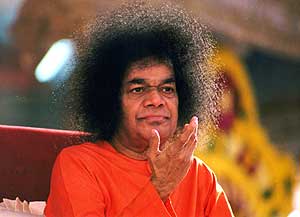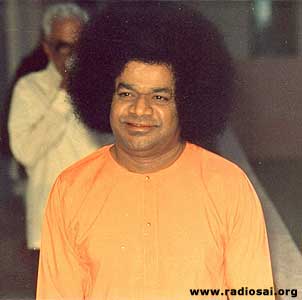 |
 |
 |
Volume
5 - Issue 02 FEBRUARY 2007
|
CONVERSATIONS WITH SAI (Hislop and an interpreter were having breakfast with Swami. Two men, Mr. XY and Mr. CD, entered the room, and Mr. XY fell at Swami's feet. He was in tears, and it was obvious that some grave and sad errand had brought him to Swami. Hislop and his companion immediately left the room. Shortly, the two men left and Baba called Hislop and the companion into His presence again. Names of persons have been changed so as not to disclose identities). THE ATMA IS EVERYWHERE H (HISLOP): Does the Atma (spirit) have a location in the body where the attention may be fixed in meditation? Is the Atma considered to have a 'seat'? SAI: The Atma is everywhere, but for the purpose of sitting in meditation, the life principle can be considered as being ten inches above the navel and at the centre of the chest. An inch in this measurement is the width of the thumb at the first j oint. H: I have read that the seat of the Atma is found to be at the right side of chest centre, that is where one points at himself. SAI: That the seat of the Self is at the right is just a viewpoint. Left handed people point differently. H: Devotees often ask what happens after death. All that I am able to reply is that I understand from Swami that the after-death experience is not uniform, that, it is not the same for every person.
SAI: That is the correct answer. In each case there is a corpse. That is similar. But beyond that, it is not similar. H: Well, Swami, one has to die. Is there some skill in dying? That is, is there a correct road through death which one can hold to and not get lost in the process SAI: That is not up to you at the time. You are influenced at that time by the net effect of your life. H: Swami says that God acts to save the devotee from perdition. What is meant by perdition? SAI: What do you understand from the word? H: It seems to me that it means Hell. SAI: That is just mental. H: But the Buddha speaks of Hell as a place. SAI: It is a place. A place of the mind. A mental state in which there is much worry and suffering. It is an after-death state. Sai is here to guide His devotees so they do not fall into that state. CONCENTRATION AND MEDITATION H: Swami points out that we already have and use a very high order of concentration in our daily lives. Then why is concentration not automatic in spiritual practice? SAI: Without concentration nothing can be done. And we use that concentration throughout the day. Why is that same concentration so difficult to come by in spiritual matters? Because the mind is outward turned, and by desire the mind clings to objects. But the mind can be trained to concentrate inwardly, and the heart can be cultured to grow with love for God. How? By Sadhana. The best sadhana is that every act through the day be done as worship of God. God is like the electric power. Heart is the light bulb. The wiring is the discipline. The switch is the intelligence. The act of turning the switch is morning, noon or evening meditation. Once the electric switch, the wiring and bulb are in, nothing more need be done. Just turn the switch and there is light. A fence is placed around a young tree to protect it. The same precautions must be observed in meditation. People think it is all right to meditate in any place. There are currents, there is will power. There is a strong current passing into the earth. Because of this, the earth exerts a very strong attraction. In meditation it is advisable to insulate oneself from such currents. For this reason, meditators sit on a plank and cover their shoulders with a woolen shawl. Once the person has grown strong in his meditation, he may sit anywhere and not suffer for it.
H: There must be a second or a fraction between one thought and another, and also between sleep and waking. No doubt that state in between must be something special? SAI: Find out. Continue practice to catch the interval between sleep and waking. Do it with love. H: Swami, seeing a corpse one can understand that the body has no life of its own. But how can the mind be associated wi th a body that is inert? SAI: There is the inert body. There is the supreme consciousness. And in between the two there is the mind which is inert but which appears to be alive because it is infused with consciousness. Just as with iron which when heated burns and does so because it has been penetrated by fire; thus it is not the iron that burns, but it is the fire that burns. The whole mirage, the whole thing arises from thought. From the identification of 'I' with the body, all troubles and complications arise. Since it is the mind that has woven this web of identification with body, it is the mind that must now turn and seek one's true nature through discrimination, renunciation and inquiry. Both ego and intelligence may be included in the word 'mind'. JYOTHI MEDITATION H: Swami, in meditation some of the westerners are taking light alone, not the quite definite form of the Jyothi, but just a formless light and they are concentrating on that and projecting that. Is it correct to make formless light as the object of concentration? SAI: It is not practical to attempt to concentrate on that which has no form. To concentrate on the Jyothi, is an illustration. The object of concentration can be sound form, the Jyothi, etc. It needs to be something concrete. It is not easy to fix the mind on the abstract. H: Is there a particular pathway along which the flame, the Jyothi, should be moved in the body? SAI: The light is first moved into the heart which is conceived as a lotus, the petals of which will open. The Jyothi is then moved to other body parts. There is no particular sequence. But important is the final body station, which is the head. There the light becomes a crown enshrining and covering the head. The light is then moved outside, from the particular to the universal. Move the light into relatives, friends, enemies, trees, animals, birds until the entire world and all its forms are seen to have the same light at their centre as has been found to be within oneself. The idea of moving the light into the universal phase, the idea of universality is that the same divine light is present in everyone and everywhere. To impress this universality on the mind, we do the spreading of the light outside one's own body. One should understand that what comes about in meditation as one moves deeply into it, is not the thinking of the light, but the forgetting of the body and thereby the direct experience that the body is not oneself. This is the stage of contemplation when the body is totally forgotten. It cannot be forced. It comes about by itself and is the stage that naturally follows correct concentration. Vivekananda said that in meditation he was unable to find his body; where was this body? He could not find it. Seeing the light and moving the light here and there is to give work to the mind, to keep the mind occupied in the right direction so that the mind will not be thinking of this and that and thus interfering with the process of becoming more and more quiet. Spreading the light into its universal phase, sending the light into every other body, and when one is so concentrated in it that he is no longer conscious of his body, is the stage of contemplation. As contemplation deepens, the stage of meditation comes about of its own volition. It cannot be forced. If the meditator remains conscious of himself that he is engaged in meditation, then he is not meditating but is still in the preliminary stage, at the beginning of concentration.
There are the three stages: concentration, contemplation and meditation. When contemplation deepens it moves naturally into meditation. Meditation is entirely above the senses. In the state of meditation, the meditator, the object of his meditation and the process of meditation have fallen away, and there is only one, and that One is God. All that may change has fallen away and Tat Twam Asi, That Thou Art, is the state that exists. As one gradually returns to his customary and habitual state of consciousness, the Jyothi is again placed in the heart and kept lighted there throughout the day. H: In meditation on the form of God, Swami says that transition into the states of contemplation and meditation occurs naturally without the volition of the person who is meditating. But how does this tie into the meditation on light where the meditator deliberately and with volition moves the Jyothi here and there? SAI: The three stages, concentration which is below the senses, meditation which is entirely above the senses and contemplation which lies between and is partially within the senses and partially above the senses, which is on the border of each, this is the experience in genuine meditation whether the object taken be form or light. There is no essential difference. If the devotee has a form of God to which he is particularly devoted, he may merge that form into the Jyothi, and that form is most attractive to him and is the object of his concentration and is seen to be within the light wherever it is seen. Or, the concentration may be just on the form of God, for God is universal in every form. Again, the object chosen is just a device to allow one to sink deeply into quietness and to allow the body, which is non-self, to fall away out of consciousness. Anything concrete, such as light, form or sound may be chosen as the object of concentration. It is not possible just to move directly into the stage of meditation. THE KUNDALINI H: In speaking of yogas, Swami said that bhakthi yoga, devotion to God, was the only yoga worth the bother, that the others were useless. But the westerners complain that Ramakrishna Paramahamsa describes how he saw the kundalini factor rise and open each chakra. What is the correct reply to this doubt? SAI: Ramakrishna used the chakras as symbols for locations of greater sensitivity along the spinal column. There is a great deal of misunderstanding about this so called kundalini meditation. The chakra is a wheel. There are no wheels on the spinal column. The wheel is taken as a symbol because the circulation of the blood is circular. The discs of the spinal column are also circular. By placing the 'wheel' at various points along the spinal column and giving these points particular names, one is able to fix his mind on those stipulated areas and move the mind from one to the other. H: But Swami, how about the idea that the snake of Kundalini awakens at the base of the spine and activates each chakra as it rises up? SAI: That energy is prana. It is imagined as rising up the spine by the practice of Pranayama. The practice of Pranayama is dangerous unless all circumstances are exactly correct. It is not necessary, and Swami advises against it. The area between the 9th and 12th vertebrae is especially sensitive. An injury there can result in paralysis. Meditation as described by Swami is the royal road, the easy path. Why bother with other practices? For meditation to be effective there must be steady practice with no hurry and no worry. With steady practice, the person will become quiet and the state of meditation will naturally come about. To think otherwise is weakness.
Success is assured. Call upon God, He will help you. He will respond and He Himself will be your guru. He will guide you. He will always be at your side. Think God, see God, hear God, eat God, drink God, love God. That is the easy path, the royal road to your goal of breaking ignorance and the realization of your true nature, which is one with God. H: Swami, the westerners are extremely interested in everything that Swami says and they think and talk about it. The fact that the breath is saying 'Sohum' 21,600 times a day has some of the people puzzled, because they say they do not experience breathing at that rate? SAI: The 21,600 breaths per day is the typical experience. It is the average of one's life. At times of exertion or stress the breathing will be very fast; at times of peace and quiet it will be slow. Some people may have an average of more than 21,600 breaths per day. A practiced yogi may average not 15 breaths per minute, but as low as 6 or 7 per minute. The slower the breathing, the longer the life span. The short-life donkey will breathe some 40 times per minute. The long-life snake will breathe 3 or 4 times per minute. H: For us westerners, is there something of the essence, some test that could be applied to action that would point out the correct dharma for any role in life? SAI: There is not one dharma for Indians and another for Westerners. Dharma is universal. Yes, there is a test that may be applied to any action and you may thereby determine if it is according to dharma. Let not that which you do, harm or injure another. This flows from the recognition that the light, which is God, is the same in every form and if you injure another you are injuring that same light that is yourself. Dharma enables you to come to the recognition that anything that is bad for another form is also bad for you. The test for dharmic action is stated very clearly in the Christian religion. That is: Do unto others as you would have them do unto you. H: People have their previous meditations prior to coming to a Sathya Sai Baba Centre. How should they now evaluate their present meditation procedure? Interpreter: This question is answered by Swami's description of genuine meditation. If the meditation engaged in by the new member of the Centre falls short of that, then he may consider following Swami's guidance in the matter. (To be continued...) – Heart2Heart Team |
| You can write to us at : h2h@radiosai.org |
Vol 5 Issue 02 - FEBRAURY 2007
|
Best viewed in Internet Explorer - 1024 x 768 resolution. |




